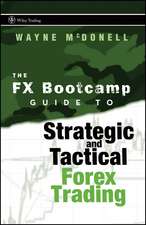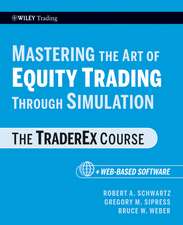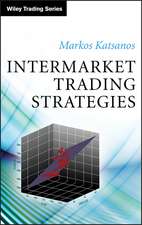Electronic vs. Floor Based Trading: Zicklin School of Business Financial Markets Series
Editat de Robert A. Schwartz, John Aidan Byrne, Antoinette Colaninnoen Limba Engleză Hardback – 6 dec 2005
| Toate formatele și edițiile | Preț | Express |
|---|---|---|
| Paperback (1) | 934.24 lei 6-8 săpt. | |
| Springer Us – 23 noi 2010 | 934.24 lei 6-8 săpt. | |
| Hardback (1) | 945.62 lei 6-8 săpt. | |
| Springer Us – 6 dec 2005 | 945.62 lei 6-8 săpt. |
Din seria Zicklin School of Business Financial Markets Series
- 15%
 Preț: 629.10 lei
Preț: 629.10 lei - 15%
 Preț: 640.37 lei
Preț: 640.37 lei - 18%
 Preț: 946.87 lei
Preț: 946.87 lei - 15%
 Preț: 637.59 lei
Preț: 637.59 lei - 18%
 Preț: 945.62 lei
Preț: 945.62 lei - 18%
 Preț: 931.39 lei
Preț: 931.39 lei - 18%
 Preț: 935.53 lei
Preț: 935.53 lei - 20%
 Preț: 548.76 lei
Preț: 548.76 lei - 15%
 Preț: 639.73 lei
Preț: 639.73 lei - 18%
 Preț: 941.38 lei
Preț: 941.38 lei - 15%
 Preț: 637.93 lei
Preț: 637.93 lei - 20%
 Preț: 550.76 lei
Preț: 550.76 lei - 18%
 Preț: 884.56 lei
Preț: 884.56 lei - 18%
 Preț: 887.24 lei
Preț: 887.24 lei - 15%
 Preț: 695.19 lei
Preț: 695.19 lei - 15%
 Preț: 636.80 lei
Preț: 636.80 lei
Preț: 945.62 lei
Preț vechi: 1153.19 lei
-18% Nou
Puncte Express: 1418
Preț estimativ în valută:
180.94€ • 189.43$ • 149.72£
180.94€ • 189.43$ • 149.72£
Carte tipărită la comandă
Livrare economică 05-19 aprilie
Preluare comenzi: 021 569.72.76
Specificații
ISBN-13: 9780387299099
ISBN-10: 0387299092
Pagini: 176
Ilustrații: XVI, 176 p.
Dimensiuni: 156 x 235 x 13 mm
Greutate: 0.45 kg
Ediția:2006
Editura: Springer Us
Colecția Springer
Seria Zicklin School of Business Financial Markets Series
Locul publicării:New York, NY, United States
ISBN-10: 0387299092
Pagini: 176
Ilustrații: XVI, 176 p.
Dimensiuni: 156 x 235 x 13 mm
Greutate: 0.45 kg
Ediția:2006
Editura: Springer Us
Colecția Springer
Seria Zicklin School of Business Financial Markets Series
Locul publicării:New York, NY, United States
Public țintă
Professional/practitionerCuprins
Getting the Trades Made.- Increasing Returns by Decreasing Trading Costs.- Operations of a Floor Broker.- Achieving Best Execution Through Market Structure Development.- Electronic Trading.- Hybrid Markets.- Electronic and Floor-Based Trading: The Nyse Hybrid Market.- The Economic Value of a Trading Floor: Evidence from the American Stock Exchange.
Notă biografică
Robert A. Schwartz is Marvin M. Speiser Professor of Finance and University Distinguished Professor in the Zicklin School of Business, Baruch College, CUNY. Before joining the Baruch faculty in 1997, he was Professor of Finance and Economics and Yamaichi Faculty Fellow at New York University's Leonard N. Stern School of Business, where he had been a member of the faculty since 1965. Professor Schwartz received his Ph.D. in Economics from Columbia University. His research is in the area of financial economics, with a primary focus on the structure of securities markets. He has published numerous journal articles and eleven books, including Equity Markets in Action: The Fundamentals of Liquidity, Market Structure and Trading, Wiley & Sons, 2004, and Reshaping the Equity Markets: A Guide for the 1990s, Harper Business, 1991 (reissued by Business One Irwin, 1993). He has served as a consultant to various market centers including the New York Stock Exchange, the American Stock Exchange, Nasdaq, the London Stock Exchange, Instinet, the Arizona Stock Exchange, Deutsche Börse, and the Bolsa Mexicana. From April 1983 to April 1988, he was an associate editor of The Journal of Finance, and he is currently an associate editor of the Review of Quantitative Finance and Accounting, the Review of Pacific Basin Financial Markets and Policies, and The Journal of Entrepreneurial Finance & Business Ventures, and is a member of the advisory board of International Finance. In December 1995, Professor Schwartz was named the first chairman of Nasdaq's Economic Advisory Board, and he served on the EAB until Spring 1999.
Textul de pe ultima copertă
Historically, specialists and other floor brokers, in direct contact on the trading floor, have been at the heart of operations at the national U.S. equity exchanges. At the other end of the spectrum, electronic trading platforms have characterized most other equity markets globally for many years. Recent developments at the NYSE have moved in this direction, but fundamental questions effecting market quality remain. Can the unique services offered by the floor be provided as effectively in an electronic environment? Which environment would institutional and retail traders each find most suitable to their special needs? Which environment offers better price and quantity discovery? These are some of the questions that are addressed in this book, while providing perspective on the future direction that exchange market structure is likely to follow in the coming years.
Caracteristici
Includes supplementary material: sn.pub/extras













